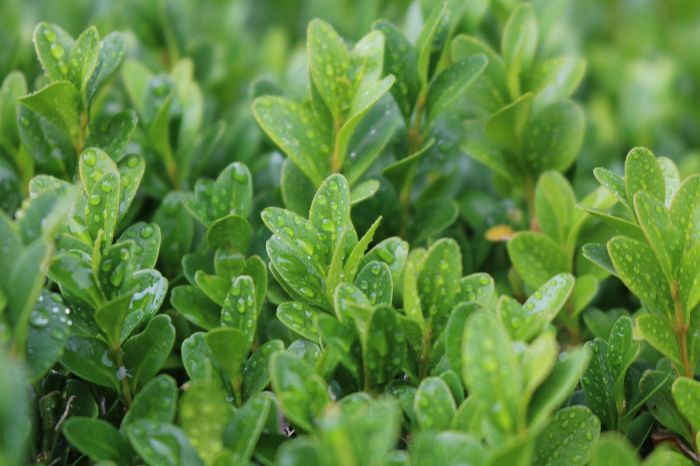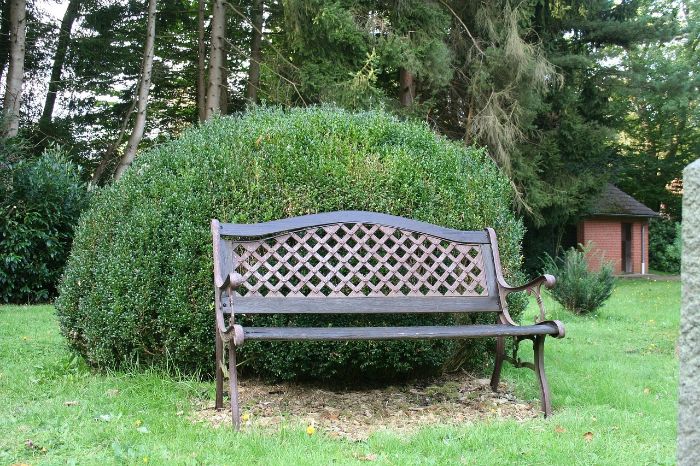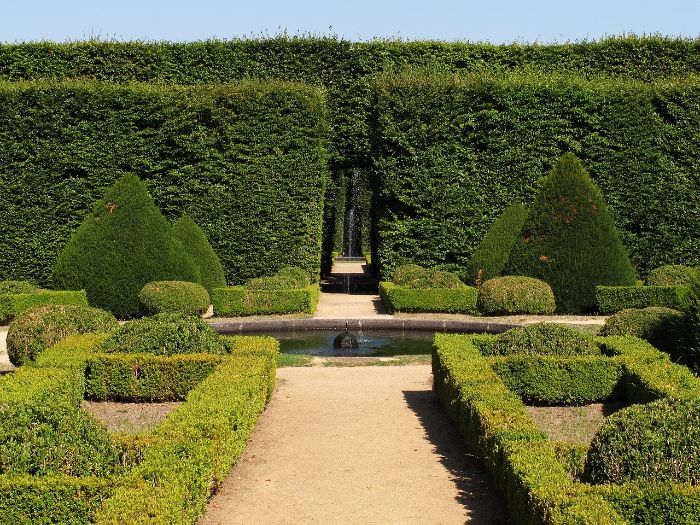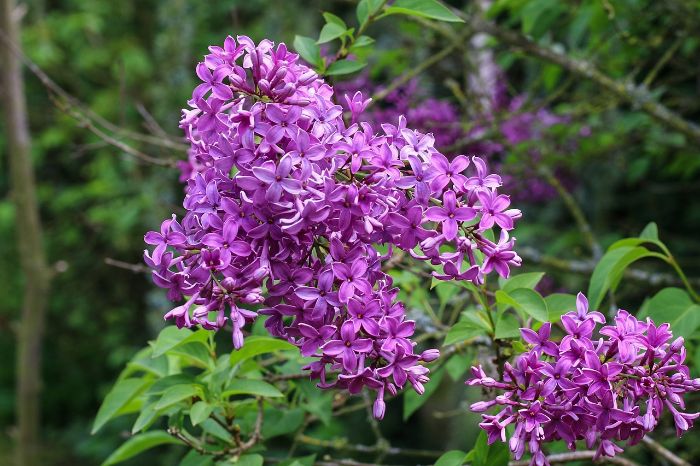Boxwoods are popular for their dense foliage and elegant structure – but keeping them healthy depends largely on consistent and well-timed watering. Many boxwood problems stem not from pests or soil, but from improper hydration. This guide breaks down how much water your boxwoods really need, how often to irrigate based on season and soil type, and what signs to watch for when adjustments are needed. Whether you’re planting new shrubs or maintaining mature ones, mastering boxwood hydration is key to long-term success.
Key Takeaways
- Boxwoods need different watering schedules depending on season, age, and soil.
- Underwatering leads to curled leaves and dry soil; overwatering causes yellowing and root rot.
- Newly planted boxwoods require deep weekly watering until roots establish.
- Water in the early morning or late afternoon to reduce evaporation.
- Use drip irrigation or slow manual watering at the base for deep root penetration.
- Mulching helps retain moisture, regulate soil temperature, and prevent disease.
Table of Contents
Boxwood Watering Requirements – How Much They Need and Why
Boxwoods require consistent soil moisture – not soggy, not dry, to maintain healthy foliage and root structure. Water supports nutrient uptake and stress resistance, especially during hot weather or transplanting. Young boxwoods are more sensitive to moisture fluctuations and need closer attention, while mature plants can tolerate slightly drier periods once established. Always aim for deep, infrequent watering rather than light, frequent sprinkling.
Why Consistent Watering Is Critical for Boxwood Health
Consistent moisture is essential for healthy root development in boxwoods. Without it, plants become stressed, making them more vulnerable to pests, leaf scorch, and fungal infections. Proper hydration not only supports growth but also strengthens the plant’s natural defense mechanisms. Fluctuations – whether too dry or too wet, create ideal conditions for disease and decline.
How to Tell If Your Boxwoods Are Overwatered or Underwatered
Boxwoods show clear signs when their watering needs are out of balance:
Symptoms of Underwatering:
- Drooping or wilting leaves
- Leaf edges curling inward
- Dry or dusty soil several inches deep
- Foliage may become dull or brittle
Symptoms of Overwatering:
- Yellowing leaves, especially on inner branches
- Leaves dropping prematurely
- Mushy or dark-colored roots when inspected
- Foul-smelling, soggy soil around the root zone
Catching these symptoms early allows for immediate correction, preventing long-term damage or disease.
How Often to Water Boxwoods
There’s no one-size-fits-all schedule for watering boxwoods. The ideal frequency depends on factors such as season, age of the plant, soil type, and climate. Understanding when to increase or reduce watering is critical to maintaining healthy shrubs year-round.
How to Adjust Boxwood Watering Through the Seasons
Boxwood watering needs shift significantly throughout the year:
- Spring and Summer – Active growth requires about 1 inch of water per week, either from rainfall or supplemental irrigation. Newly planted boxwoods need consistent, deep watering to establish roots.
- Autumn – As growth slows, reduce watering frequency. Excess moisture during this period can invite fungal issues.
- Winter (Dormant Season) – From October through April, most established boxwoods need little to no supplemental water unless there’s an extended dry spell.
Adjusting your watering schedule to match seasonal growth patterns prevents both overwatering and drought stress.
How Climate and Soil Type Affect Boxwood Watering Frequency
Your regional climate and soil composition have a major impact on how often boxwoods need water:
- In hot, dry climates, more frequent watering may be necessary, especially in sandy or fast-draining soils.
- In cool, humid regions, natural rainfall often provides sufficient moisture, and irrigation should be minimized.
- For clay soils, which retain water, allow the soil to dry slightly before watering again to avoid root suffocation.
Always check soil moisture before watering. A trowel test 2–4 inches deep helps determine whether the root zone is still adequately moist.

Best Watering Methods for Healthy Boxwoods
How you deliver water is just as important as how often. Boxwoods benefit most from deep, targeted watering at the root zone. Choosing the right method – drip irrigation or controlled manual watering, prevents water loss, reduces disease risk, and encourages strong root development.
Drip Irrigation Systems
Drip irrigation delivers water slowly and directly to the root zone, minimizing evaporation and runoff. It’s especially useful in large plantings or dry climates, where water conservation is important. This method keeps foliage dry, which helps prevent fungal diseases like Boxwood Blight. Inspect emitters regularly to ensure even coverage and proper flow.
Manual Watering Tips
Manual watering is effective when done correctly. Use a soaker hose or let a regular hose trickle at the base of each plant. Avoid spraying water on the leaves, which increases disease risk. Water deeply to ensure moisture reaches the entire root zone, not just the surface. Always test soil moisture before watering to avoid overdoing it.
Timing and Mulching Strategies for Optimal Boxwood Moisture
Two often-overlooked aspects of successful boxwood watering are when you irrigate and how you retain moisture. Strategic timing and proper mulching significantly improve water efficiency and protect plants from stress and disease.
Timing Your Watering
Water boxwoods in the early morning or late afternoon to minimize evaporation and ensure maximum soil absorption. Midday watering, especially in hot climates, leads to significant water loss and inefficient root uptake. Avoid evening watering, which can leave leaves damp overnight and increase the risk of fungal issues.
Using Mulch to Retain Moisture
Apply a 2- to 3-inch layer of organic mulch – such as shredded bark, wood chips, or compost, around the base of boxwoods. Mulch helps retain moisture, regulate soil temperature, suppress weeds, and reduce splash-up of pathogens onto foliage. Keep mulch 2 inches away from the stem to prevent rot and ensure airflow at the crown.
Avoiding Overwatering – Smart Adjustments for Boxwood Irrigation
Improper watering is one of the leading causes of poor boxwood performance. Whether it’s overwatering or watering at the wrong time, even small mistakes can lead to root rot, leaf drop, or fungal disease. Recognizing the symptoms early and adjusting your routine is critical to keeping your boxwoods healthy.

How to Fix Overwatering and Adjust Your Watering Routine
Overwatering is one of the most common causes of root damage in boxwoods. Typical signs include yellowing leaves, leaf drop, and a soggy, foul-smelling root zone. When these appear, stop watering immediately and allow the soil to dry out. Improve drainage by aerating the soil or adjusting the site if pooling is frequent.
Instead of following a fixed schedule, evaluate soil moisture regularly to guide your watering decisions. Use a trowel or your fingers to test soil 2–4 inches deep:
- If it’s moist, wait.
- If it’s dry, irrigate slowly and deeply.
- Adjust frequency after rainfall, during drought, or when seasonal temperatures shift.
These small adjustments protect roots, reduce disease risk, and keep your boxwoods healthy over time.
Adjusting Watering Schedules
To avoid overwatering, always test the soil before irrigating. Insert a finger or small trowel 2–4 inches into the soil near the root zone:
- If the soil feels moist and cool, wait before watering again.
- If it’s dry and crumbly, it’s time to irrigate.
- After rainfall or cloudy periods, reduce scheduled watering.
- In hot weather, increase watering only if the soil is drying out faster than usual.
Consistent soil checks allow you to adapt watering in real time, preventing long-term plant stress.
How to Monitor Soil Moisture and Adapt Your Boxwood Watering Plan
Long-term boxwood health depends on more than a fixed watering schedule. Instead, gardeners need to monitor soil moisture and weather patterns, adjusting irrigation to match real conditions. This proactive approach improves resilience, prevents disease, and ensures consistent growth across seasons.
Assessing Soil Moisture Levels
To check if your boxwoods need water, use a soil moisture test:
- Insert a trowel, soil probe, or your finger 2–4 inches deep near the root zone.
- If the soil feels cool and slightly moist, delay watering.
- If it feels dry or powdery, it’s time to irrigate.
- In clay soils, check for stickiness – overwatering can be hidden below the surface.
Repeat this test at multiple spots around the plant to ensure even moisture.
Long-Term Watering Strategies
As your boxwoods mature, shift from frequent shallow watering to deeper, less frequent irrigation. This encourages roots to grow deeper and become more drought-resistant. Key principles:
- Increase watering depth during hot months or droughts.
- Reduce watering frequency in cool, humid, or rainy conditions.
- Keep seasonal rainfall records and adjust irrigation accordingly.
- Use mulch and shaded root zones to slow moisture loss.
Adapting to conditions over time helps maintain resilient, low-maintenance boxwoods with strong root systems.
Conclusion
Watering boxwoods correctly is not about routine – it’s about response. Healthy boxwoods rely on deep, consistent soil moisture, tailored to the season, climate, and soil type. Using the right techniques – drip irrigation, targeted manual watering, and proper mulching, keeps roots strong and foliage vibrant.
Monitor soil conditions regularly, adapt your watering strategy when weather changes, and avoid the two most common threats: overwatering and neglect. When hydration is managed with precision, boxwoods reward you with long-lasting structure, color, and disease resistance throughout the year.
FAQ
How often should I water mature boxwoods?
Once established, boxwoods typically need deep watering every 7 to 10 days during dry periods. Always check soil moisture first to avoid overwatering.
What’s the best way to check if boxwoods need water?
Insert a trowel or your finger 2–4 inches into the soil. If it feels dry and crumbly, it’s time to water. If it’s still cool and moist, wait a few more days.
Can overwatering kill boxwoods?
Yes. Prolonged overwatering leads to root rot and fungal infections. Symptoms include yellowing leaves, soggy soil, and a musty smell near the roots.
Should I water boxwoods differently in clay vs. sandy soil?
Absolutely. Sandy soil drains quickly and requires more frequent watering. Clay holds water longer, so wait until the soil dries slightly to avoid saturation.
Is mulch necessary for boxwood hydration?
Mulch isn’t optional – it’s critical. A 2–3 inch organic layer conserves moisture, stabilizes soil temperature, and protects roots from drought and disease.
When is the worst time of day to water boxwoods?
Avoid watering during midday heat. Water evaporates quickly, and moisture left on leaves can promote disease. Early morning is the best time.










